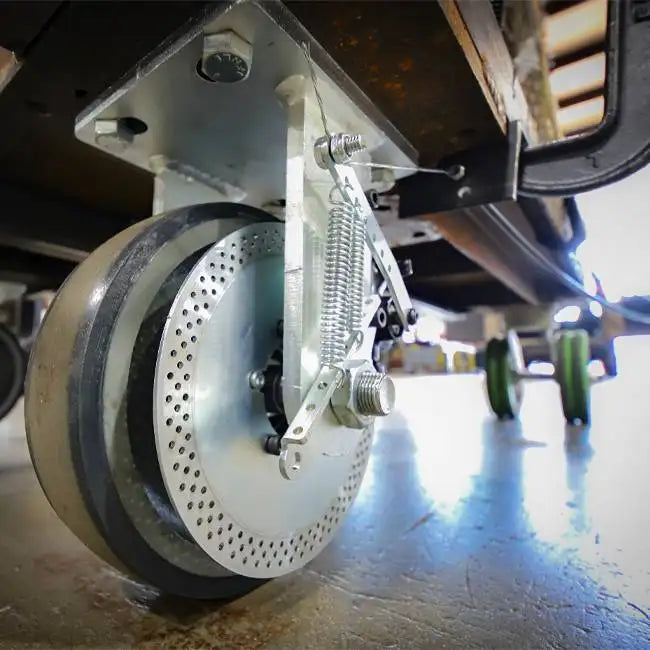
The ROI Equation: How Retractable Casters Slash the Total Cost of Ownership (TCO) for Medical Equipment
- Bearing Care, Caster Durability, caster installation guide, Caster Lubrication, Caster Maintenance, Caster Replacement Strategy, Caster ROI, Caster Selection, Caster Technology, Caster Training, Corrosion Resistant, Cost-Benefit Analysis, Debris Removal, Dual Function, Equipment Lifespan, Equipment Longevity, Floor Protection, Floor Transition, Healthcare Ergonomics, Heavy Equipment Maintenance, HOLKIE, Industrial Casters, Industrial Ergonomics, Industrial Maintenance, Industrial Mobility, Lifecycle Cost Analysis, Load Capacity, Maintenance Reduction, Medical Equipment TCO, Noise Reduction, Patient Safety, Preventative Maintenance, Shock Absorption, Space Optimization, Specialized Mobility, Stability, Technical Guide, troubleshooting, Warehouse Equipment, Wheel Materials, Workplace Safety
- 28 Dec, 2024
In the demanding world of healthcare, the true cost of critical medical equipment—from diagnostic machines to mobile operating tables—extends far beyond the initial purchase price. The hidden expenses lie in maintenance, staff injury claims, patient fall risks, and operational inefficiencies. Retractable Casters are often viewed as a simple component, but for procurement and operations managers, they represent a significant variable in the Total Cost of Ownership (TCO).
This article provides a cost-benefit analysis (CBA) framework, demonstrating how investing in high-quality retractable casters is a strategic decision that dramatically reduces long-term operational costs and maximizes your equipment’s ROI.
Reducing the Direct Costs: Maintenance, Cleaning, and Replacement
The most tangible cost savings from superior retractable casters stem from improvements in equipment lifecycle and upkeep.
Minimizing Maintenance and Downtime
Traditional casters often require locking mechanisms that are prone to failure under the corrosive effects of common medical disinfectants.
Corrosion Resistance: Premium retractable casters utilize stainless steel or corrosion-resistant polymers in their housing and axles, dramatically extending the time between failure (MTBF) and reducing the frequency of costly, unplanned replacement labor.
Precision and Longevity: By fully retracting, the equipment's base—not the caster itself—bears the load. This design eliminates caster deflection and minimizes micro-movement during critical procedures (like imaging or surgery), preserving the lifespan of both the caster components and the sensitive electronics they support.
Streamlining Sterilization and Cleaning Protocol
Hygiene directly impacts operational cost (e.g., managing hospital-acquired infections, HAIs).
Unimpeded Access: The ability to fully lift and stabilize a piece of equipment simplifies deep-cleaning protocols. Staff can easily access the floor space underneath the equipment's chassis without complex maneuvers, ensuring compliance with strict sterilization standards.
Faster Turnaround: Reduced cleaning time for equipment like stretchers and procedure carts translates directly into faster room turnaround and increased utilization rates, effectively lowering the per-use operating cost.
Cutting Indirect Costs: Safety, Staffing, and Patient Outcomes
The most significant financial benefits are often realized through the reduction of risk and improved Human Factors (Ergonomics).
Mitigating Staff Injury and Absenteeism
Musculoskeletal Disorders (MSDs) are a leading cause of workers’ compensation claims among healthcare staff.
- Reduced Push/Pull Force: High-quality retractable casters ensure ultra-low starting and rolling resistance when extended, minimizing the physical force required to move heavy equipment. This reduces the risk of back and shoulder injuries, leading to lower compensation claims and staff absenteeism.
- Ergonomics: Easy-to-engage, foot-operated retraction levers allow staff to switch between mobility and stability hands-free and without bending, protecting their joints and spine.
Enhancing Patient Safety and HCAHPS Scores
Patient stability and comfort are tied to HCAHPS (Hospital Consumer Assessment of Healthcare Providers and Systems) scores, which influence hospital reimbursement.
- Eliminating Unwanted Movement: When retracted, the equipment rests on a stable base, eliminating wobble or roll during patient transfers or critical monitoring. This directly lowers the risk of patient falls, a major liability and quality concern.
- Noise Reduction: Premium casters often feature soft, non-marking TPR or polyurethane wheels. When moving, these wheels significantly reduce ambient noise (a common patient complaint), positively impacting patient satisfaction scores.
The Long-Term ROI: Maximizing Asset Utilization
The ultimate payoff is optimizing the utilization of expensive medical assets.
- Dynamic Space Utilization: Retractable casters allow high-value equipment to be quickly moved to where it is needed—from a storage alcove to an operating room—transforming stationary equipment into a shared, mobile asset. This flexibility means fewer units are needed overall, reducing capital expenditure.
- Future-Proofing Layouts: As facility layouts change, caster-equipped devices can be re-deployed instantly, preventing the need for costly structural modifications or replacement of immovable equipment.
Conclusion: Strategic Investment in Patient-Centric Mobility
The decision to invest in high-performance retractable casters is not a simple expense; it is a strategic investment in operational efficiency, staff health, and patient safety. By providing a perfect balance of fluid mobility and rock-solid stability, these casters are proven to reduce the TCO of your medical equipment, ensuring a superior ROI for healthcare facilities dedicated to quality care.












